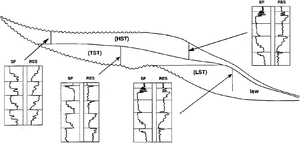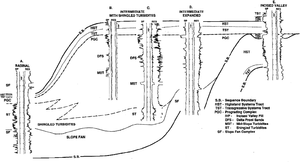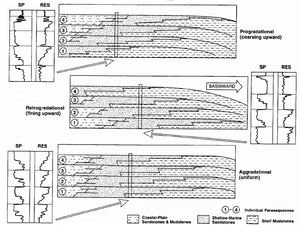Difference between revisions of "Well log sequence analysis"
Cwhitehurst (talk | contribs) |
Cwhitehurst (talk | contribs) m (added Category:Treatise Handbook 3 using HotCat) |
||
| (22 intermediate revisions by 3 users not shown) | |||
| Line 6: | Line 6: | ||
| part = Predicting the occurrence of oil and gas traps | | part = Predicting the occurrence of oil and gas traps | ||
| chapter = Exploring for stratigraphic traps | | chapter = Exploring for stratigraphic traps | ||
| − | | frompg = 21- | + | | frompg = 21-29 |
| − | | topg = 21- | + | | topg = 21-31 |
| author = John C. Dolson, Mike S. Bahorich, Rick C. Tobin, Edward A. Beaumont, Louis J. Terlikoski, Michael L. Hendricks | | author = John C. Dolson, Mike S. Bahorich, Rick C. Tobin, Edward A. Beaumont, Louis J. Terlikoski, Michael L. Hendricks | ||
| link = http://archives.datapages.com/data/specpubs/beaumont/ch21/ch21.htm | | link = http://archives.datapages.com/data/specpubs/beaumont/ch21/ch21.htm | ||
| Line 14: | Line 14: | ||
| isbn = 0-89181-602-X | | isbn = 0-89181-602-X | ||
}} | }} | ||
| − | After seismic sections have been analyzed for sequences, well logs are analyzed for sequences and systems tracts. This involves interpreting depositional lithofacies on logs using cuttings and cores and then identifying sequences and systems tracts from the interpreted logs. Stacking patterns displayed in cross | + | After seismic sections have been analyzed for sequences, well logs are analyzed for sequences and systems tracts. This involves interpreting depositional [[lithofacies]] on logs using cuttings and cores and then identifying sequences and systems tracts from the interpreted logs. Stacking patterns displayed in [[cross section]]s and individual logs show accommodation space changes which help us identify sequence and systems tracts. |
==Procedure== | ==Procedure== | ||
| − | The | + | The list below, modified from Vail<ref name=ch21r44>Vail, P., R., 1987, [http://archives.datapages.com/data/specpubs/oversiz2/data/a188/a188/0001/0000/0001.htm Seismic stratigraphy interpretation procedure], in Bally, A., W., ed., Atlas of Seismic Stratigraphy: [http://store.aapg.org/detail.aspx?id=478 AAPG Studies in Geology No. 27], p. 2.</ref> outlines a suggested procedure for well log sequence analysis. |
| − | + | # Interpret depositional lithofacies on logs using cores and cuttings to calibrate the log. | |
| − | + | # Estimate sequences and systems tracts from the interpreted lithofacies using regional [[cross section]]s with well and [http://www.merriam-webster.com/dictionary/outcrop outcrop] data. | |
| − | + | # Determine accommodation space changes from parasequence stacking patterns seen in well log cross sections (see below). | |
| − | + | # Check estimates of sequences and systems tracts: | |
| − | + | #* Correlate between wells that have biostratigraphic-time correlations, well log marker-bed correlations, and the global sea cycle chart. | |
| − | + | #* Correlate with seismic profiles. | |
| − | |||
| − | |||
| − | |||
| − | |||
| − | |||
| − | |||
| − | |||
| − | |||
| − | |||
| − | |||
| − | * Correlate between wells that have biostratigraphic-time correlations, well log marker-bed correlations, and the global sea cycle chart. | ||
| − | * Correlate with seismic profiles. | ||
| − | |||
==Parasequence stacking patterns== | ==Parasequence stacking patterns== | ||
| − | [[file:exploring-for-stratigraphic-traps_fig21-19.png|thumb|{{figure number|1}}.]] | + | [[file:exploring-for-stratigraphic-traps_fig21-19.png|300px|thumb|{{figure number|1}}Three stacking patterns. From Hyne;<ref name=Hyne>Hyne, N. J., 1995, Sequence stratigraphy: a new look at old rocks, in N. J. Hyne, ed., Sequence Stratigraphy of the Mid Continent: Tulsa Geological Society Special Publication 4, p. 5–20.</ref> courtesy Tulsa Geological Society. Modified from Van Wagoner et al.;<ref>Van Wagoner, J. C., R. M. Mitchum, K. M. Campion, and V. D. Rahmanian, 1990, Siliciclastic Sequence Stratigraphy in Well Logs, Cores and Outcrops: Concepts for High-Resolution Correlation of Time and Facies: [http://store.aapg.org/detail.aspx?id=1196 AAPG Methods in Exploration Series No. 7], 55 p.</ref> courtesy AAPG.]] |
| − | Parasequences stack into three basic patterns as a result of the interaction of accommodation and rate of sediment supply: | + | Parasequences stack into [[Depocenter#Sediment_supply_rate_and_facies_patterns|three basic patterns]] as a result of the interaction of accommodation and rate of sediment supply: |
* Progradational | * Progradational | ||
* Retrogradational | * Retrogradational | ||
| Line 51: | Line 38: | ||
==Stacking patterns for systems tracts== | ==Stacking patterns for systems tracts== | ||
| − | Systems tracts often have characteristic parasequence stacking patterns. Stacking patterns of the basin-floor fan and slope fan, contained within the lowstand systems tract, are difficult to identify. The table below summarizes typical stacking patterns for the three systems tracts. | + | Systems tracts often have characteristic parasequence stacking patterns. Stacking patterns of the [http://www.sepmstrata.org/TerminologyList.aspx basin-floor fan] and slope fan, contained within the lowstand systems tract, are difficult to identify. The table below summarizes typical stacking patterns for the three systems tracts. |
{| class = "wikitable" | {| class = "wikitable" | ||
| Line 80: | Line 67: | ||
==Log patterns for systems tracts== | ==Log patterns for systems tracts== | ||
| − | [[file:exploring-for-stratigraphic-traps_fig21-20.png|thumb|{{figure number|2}}Modified. Copyright: Hyne | + | [[file:exploring-for-stratigraphic-traps_fig21-20.png|300px|thumb|{{figure number|2}}Characteristic parasequence stacking patterns for the high-stand (HST), transgressive (TST), and lowstand (LST) systems tracts of a passive margin basin third-order depositional sequence. Modified. Copyright: Hyne;<ref name=Hyne /> courtesy Tulsa Geological Society.]] |
[[:file:exploring-for-stratigraphic-traps_fig21-20.png|Figure 2]] shows the characteristic parasequence stacking patterns for the high-stand (HST), transgressive (TST), and lowstand (LST) systems tracts of a passive margin basin third-order depositional sequence. | [[:file:exploring-for-stratigraphic-traps_fig21-20.png|Figure 2]] shows the characteristic parasequence stacking patterns for the high-stand (HST), transgressive (TST), and lowstand (LST) systems tracts of a passive margin basin third-order depositional sequence. | ||
| Line 86: | Line 73: | ||
==LST example== | ==LST example== | ||
| − | [[file:exploring-for-stratigraphic-traps_fig21-21.png|thumb|{{figure number|3}}.]] | + | [[file:exploring-for-stratigraphic-traps_fig21-21.png|300px|thumb|{{figure number|3}}Cross section from the Late Cenozoic of the Gulf of Mexico. From Mitchum et al.;<ref>Mitchum, R. M., P. R. Vail, and J. B. Sangree, 1977, [http://archives.datapages.com/data/specpubs/seismic1/data/a165/a165/0001/0100/0117.htm Seismic stratigraphy and global changes in sea level, part 6: stratigraphic interpretations of seismic reflection patterns in depositional sequences], in C. E. Payton, ed., Seismic Stratigraphy and Applications to Hydrocarbon Exploration: [http://store.aapg.org/detail.aspx?id=1157 AAPG Memoir 26], p. 117–133.</ref> courtesy AAPG.]] |
| − | The cross section in [[:file:exploring-for-stratigraphic-traps_fig21-21.png|Figure 3]] is from the Late Cenozoic of the Gulf of Mexico. It shows the well log responses of a lowstand systems tract (labeled as PGC, or prograding complex, on the cross section). Log A is completely basinal with a slope fan overlain by shingled | + | The cross section in [[:file:exploring-for-stratigraphic-traps_fig21-21.png|Figure 3]] is from the Late [[Cenozoic]] of the [[Gulf of Mexico]]. It shows the well log responses of a lowstand systems tract (labeled as PGC, or prograding complex, on the cross section). Log A is completely basinal with a slope fan overlain by shingled [[turbidite]]s. Logs B and C have deltaic and delta front sands, and midslope turbidite sands. Log D has a “classic” coarsening-upward pattern. Log E has incised valley sands. |
==See also== | ==See also== | ||
| Line 96: | Line 83: | ||
* [[Seismic sequence analysis]] | * [[Seismic sequence analysis]] | ||
* [[Combining well log with seismic sequence analysis]] | * [[Combining well log with seismic sequence analysis]] | ||
| + | * [[Regional maps and cross sections]] | ||
| + | * [[Cross section]] | ||
==References== | ==References== | ||
| Line 107: | Line 96: | ||
[[Category:Predicting the occurrence of oil and gas traps]] | [[Category:Predicting the occurrence of oil and gas traps]] | ||
[[Category:Exploring for stratigraphic traps]] | [[Category:Exploring for stratigraphic traps]] | ||
| + | [[Category:Treatise Handbook 3]] | ||
Latest revision as of 16:53, 4 February 2022
| Exploring for Oil and Gas Traps | |

| |
| Series | Treatise in Petroleum Geology |
|---|---|
| Part | Predicting the occurrence of oil and gas traps |
| Chapter | Exploring for stratigraphic traps |
| Author | John C. Dolson, Mike S. Bahorich, Rick C. Tobin, Edward A. Beaumont, Louis J. Terlikoski, Michael L. Hendricks |
| Link | Web page |
| Store | AAPG Store |
After seismic sections have been analyzed for sequences, well logs are analyzed for sequences and systems tracts. This involves interpreting depositional lithofacies on logs using cuttings and cores and then identifying sequences and systems tracts from the interpreted logs. Stacking patterns displayed in cross sections and individual logs show accommodation space changes which help us identify sequence and systems tracts.
Procedure[edit]
The list below, modified from Vail[1] outlines a suggested procedure for well log sequence analysis.
- Interpret depositional lithofacies on logs using cores and cuttings to calibrate the log.
- Estimate sequences and systems tracts from the interpreted lithofacies using regional cross sections with well and outcrop data.
- Determine accommodation space changes from parasequence stacking patterns seen in well log cross sections (see below).
- Check estimates of sequences and systems tracts:
- Correlate between wells that have biostratigraphic-time correlations, well log marker-bed correlations, and the global sea cycle chart.
- Correlate with seismic profiles.
Parasequence stacking patterns[edit]
Parasequences stack into three basic patterns as a result of the interaction of accommodation and rate of sediment supply:
- Progradational
- Retrogradational
- Aggradational
Figure 1 shows these three stacking patterns.
Stacking patterns for systems tracts[edit]
Systems tracts often have characteristic parasequence stacking patterns. Stacking patterns of the basin-floor fan and slope fan, contained within the lowstand systems tract, are difficult to identify. The table below summarizes typical stacking patterns for the three systems tracts.
| Systems tract | Stacking pattern |
|---|---|
Lowstand
|
Difficult to recognize |
| Transgressive | Retrogradational |
Highstand
|
Aggradational |
Log patterns for systems tracts[edit]

Figure 2 shows the characteristic parasequence stacking patterns for the high-stand (HST), transgressive (TST), and lowstand (LST) systems tracts of a passive margin basin third-order depositional sequence.
LST example[edit]

The cross section in Figure 3 is from the Late Cenozoic of the Gulf of Mexico. It shows the well log responses of a lowstand systems tract (labeled as PGC, or prograding complex, on the cross section). Log A is completely basinal with a slope fan overlain by shingled turbidites. Logs B and C have deltaic and delta front sands, and midslope turbidite sands. Log D has a “classic” coarsening-upward pattern. Log E has incised valley sands.
See also[edit]
- Geometrical analysis
- Procedure for geometrical analysis
- Other correlation features
- Seismic sequence analysis
- Combining well log with seismic sequence analysis
- Regional maps and cross sections
- Cross section
References[edit]
- ↑ Vail, P., R., 1987, Seismic stratigraphy interpretation procedure, in Bally, A., W., ed., Atlas of Seismic Stratigraphy: AAPG Studies in Geology No. 27, p. 2.
- ↑ 2.0 2.1 Hyne, N. J., 1995, Sequence stratigraphy: a new look at old rocks, in N. J. Hyne, ed., Sequence Stratigraphy of the Mid Continent: Tulsa Geological Society Special Publication 4, p. 5–20.
- ↑ Van Wagoner, J. C., R. M. Mitchum, K. M. Campion, and V. D. Rahmanian, 1990, Siliciclastic Sequence Stratigraphy in Well Logs, Cores and Outcrops: Concepts for High-Resolution Correlation of Time and Facies: AAPG Methods in Exploration Series No. 7, 55 p.
- ↑ Mitchum, R. M., P. R. Vail, and J. B. Sangree, 1977, Seismic stratigraphy and global changes in sea level, part 6: stratigraphic interpretations of seismic reflection patterns in depositional sequences, in C. E. Payton, ed., Seismic Stratigraphy and Applications to Hydrocarbon Exploration: AAPG Memoir 26, p. 117–133.
